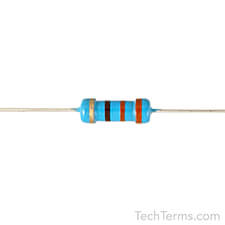Resistor
A resistor is an electrical component that limits the flow of electric current. One or more resistors can be used to provide the correct amount of current to specific components within an electronic device.
Resistors are often soldered onto a printed circuit board to limit the amount of current that flows to different electrical paths. If too little current reaches a component, it may not operate. If too much current is allowed through, it can damage the component. Therefore, resistors play an important role in an electronic circuit.
Several types of resistors exist, but most are made up of carbon and an insulating material, such as ceramic. The current flows in one end and the remaining current flows out the other. The resulting current is inversely proportional to the resistance. This is defined in Ohm's law, which states that the current (I) is equal to the voltage (V) divided by the resistance (R).
Resistors are often color-coded to visually represent their resistance levels. A typical axial-lead resistor, for instance, is cylindrical in shape and has several colored stripes. The first few stripes represent digits, followed by a stripe which represents a multiplier (10x, 100x, etc.) On the other end is a stripe that represents the tolerance, which defines the accuracy of the resistor. Some resistors also include one more band that represents the temperature coefficient.
NOTE: Resistors are represented in circuit diagrams by a jagged line. They are usually labeled R1, R2, R3, etc.
 Test Your Knowledge
Test Your Knowledge